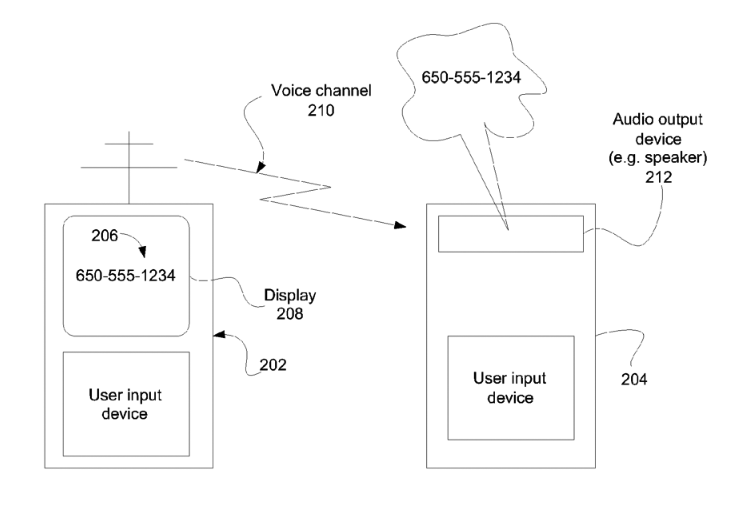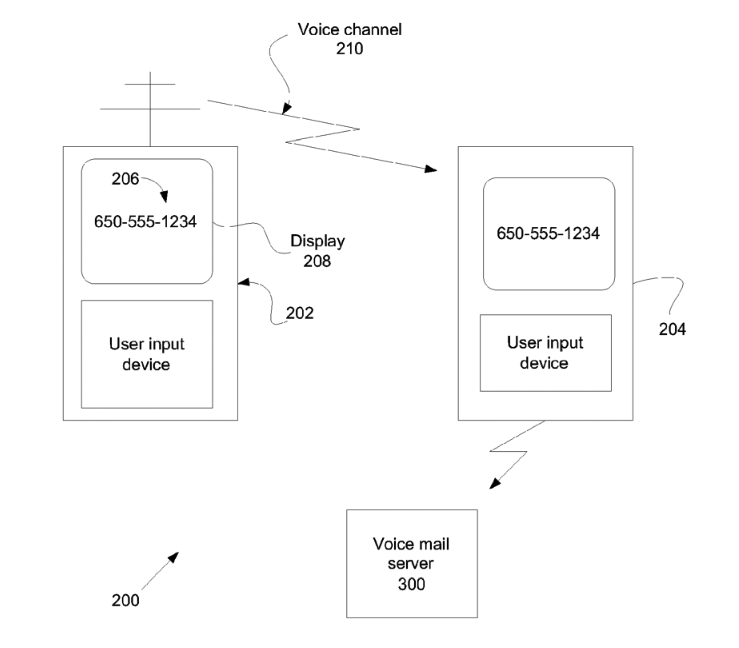The concept is detailed in a company filing made this past November and discovered for the first time by AppleInsider on Thursday. As Apple explains, conventional text messaging systems require the use of what is referred to as a backend server that may be limited in the amount of information that can be handled at a particular time and is therefore capacity limited.
Furthermore, the company notes that reading of text messages can be troublesome due to in part to the small size of the typical display screen on a handheld device, especially in situations where the recipient is impaired or preoccupied with another task, such as driving.
"With the rapid deployment, proliferation, and technical advancement of mobile personal communication devices, such as cell phones, a user of these devices is presented with any number of ways to communicate with another user," Apple wrote in the filing.
"For example, a user can send type a text message using, for example, Short Message Service-Point to Point (SMS-PP) protocol as defined in GSM recommendation 03.40 where messages are sent via a store-and forward mechanism to a Short Message Service Center (SMSC), which will attempt to send the message to the recipient and possibly retry if the user is not reachable at a given moment. Therefore, SMS-PP requires the use of a backend server to provide the necessary support for transmission of data between sender and receiver."
As such, the iPhone maker calls for a new mechanism whereby data is passed between a sender and receiver unit by way of voice channel only, bypassing use of the data channel used in conventional arrangements.
"In this way, a sender can select that data which he/she desires to send to a receiver unit using by first converting the data into an appropriate vocal/voice format which is then forwarded to a receiver unit by way of the voice channel," Apple said. "Once received at the receiver unit, the vocalized data can be converted to an audio signal, which is then output by way of an audio output device (such as a speaker, earphone, etc.)."
More specifically, the filing suggests that a sender would be able to vocalize any textual data on their display screen — such as a phone number — in order to pass it by way of a voice channel to another iPhone or any number of other iPhones or compatible personal communication devices. Once received by the recipient, processing of the vocalized data would be performed based upon a prompted user request or based upon a pre-selected protocol.
"For example, once received [by an iPhone], the vocalized phone number can be passed to an audio output device that (in the case of a speaker) generates an audible rendition of the vocalized phone number," Apple wrote. "In another case, the vocalized phone number is forwarded to a voice mail server where the receiver records the vocalized phone number as a voice mail message for subsequent playback."
In the latter case, Apple notes that the sender can pre-select the option that forces the generated audio message to stored in the receiver's voice mail server. Alternatively, the company said additional processing can be performed whereby any vocalized multimedia data received is automatically converted back to text and displayed and/or converted to an audible message.
Additionally, Apple said the concept is open to alterations and permutations, which would include a walkie-talkie-like feature, where the sender transmits a voice snippet rather than text clippings. The filing made November 23, 2009 is credited to iPod grandfather and former Apple vice president Anthony Fadell.
 Slash Lane
Slash Lane








-m.jpg)






 Charles Martin
Charles Martin

 Malcolm Owen
Malcolm Owen
 William Gallagher
William Gallagher

 Christine McKee
Christine McKee
 Wesley Hilliard
Wesley Hilliard








43 Comments
"brainstrorming" is an unfortunate word to use given the previous article!
This idea sounds like a cell phone modem. It's just a slight rejiggering of an old technology.
"brainstrorming" is an unfortunate word to use given the previous article!
I do agree. Where's the novelty in this? Seems like existing text-to-speech things and Push-to-talk over Cellular (PoC). Or am I missing something here? Yes they are combining some parts, but voice SMS playback and phone number playback has been available on phones for years. PoC (Nextel in the US) is established tech as well.
I do agree. Where's the novelty in this? Seems like existing text-to-speech things and Push-to-talk over Cellular (PoC). Or am I missing something here? Yes they are combining some parts, but voice SMS playback and phone number playback has been available on phones for years. PoC (Nextel in the US) is established tech as well.
So how come no one's done it yet, if it's so obvious?
And it's not voice SMS playback.
This sounds like converting an SMS (or other text, e.g. a phone number) to voice at the sender's phone. Then send the voice message via the voice channel - e.g. a voice message instead of a text message.
Or it could be converting the text into an encoded audio signal (good old modem tech from the 80s Squeeeeee!). Sending that via voice mail and the receiver decoding back to data. Reading the article again, it also seems to cover using voice recognition to convert back to data. So:
Sender: "555-1212" gets converted to spoken "five five five one two one two"
Receiver: Either speak the message, voice recognize it to turn it back to "555-1212", and/or save the "vocalized data" to voice mail for later use.
I can't imagine audio encoding of data would be anywhere near as efficient as using a carrier's data channel. And I'd have to think carriers would frown on the inefficient use of bandwidth.
And how reliable is the voice channel? Does the waveform encoded at the sender make it to the receiver with enough fidelity to encode data?
I'm guessing "company filing" means a patent filing? The article doesn't use the word patent anywhere. Assuming it does mean patent filing, this could be a case of coming up with an idea and defensively patenting it before anyone else does - whether or not implementing the concept makes any business sense.
If Apple does follow through on a capability like this, I expect resistance from carriers. Someone will have to run the numbers on cost of sending a "spoken text message" vs sending a "data text message". If one has a high minute plan with pay per text message (and especially unlimited night & weekend minutes), it could be a lot cheaper for the user to send "five five five one two one two" and let the phones handle text-to-speech-to-text instead of sending actual text messages.
The big problem I see with this is delivery. Data is delivered immediately - it goes to the phone without the user answering the call. But voice invokes the ringer and the user has to answer the phone to get the message or navigate to voice mail to retrieve it later. That hassle could make this technique less useful.
- Jasen.